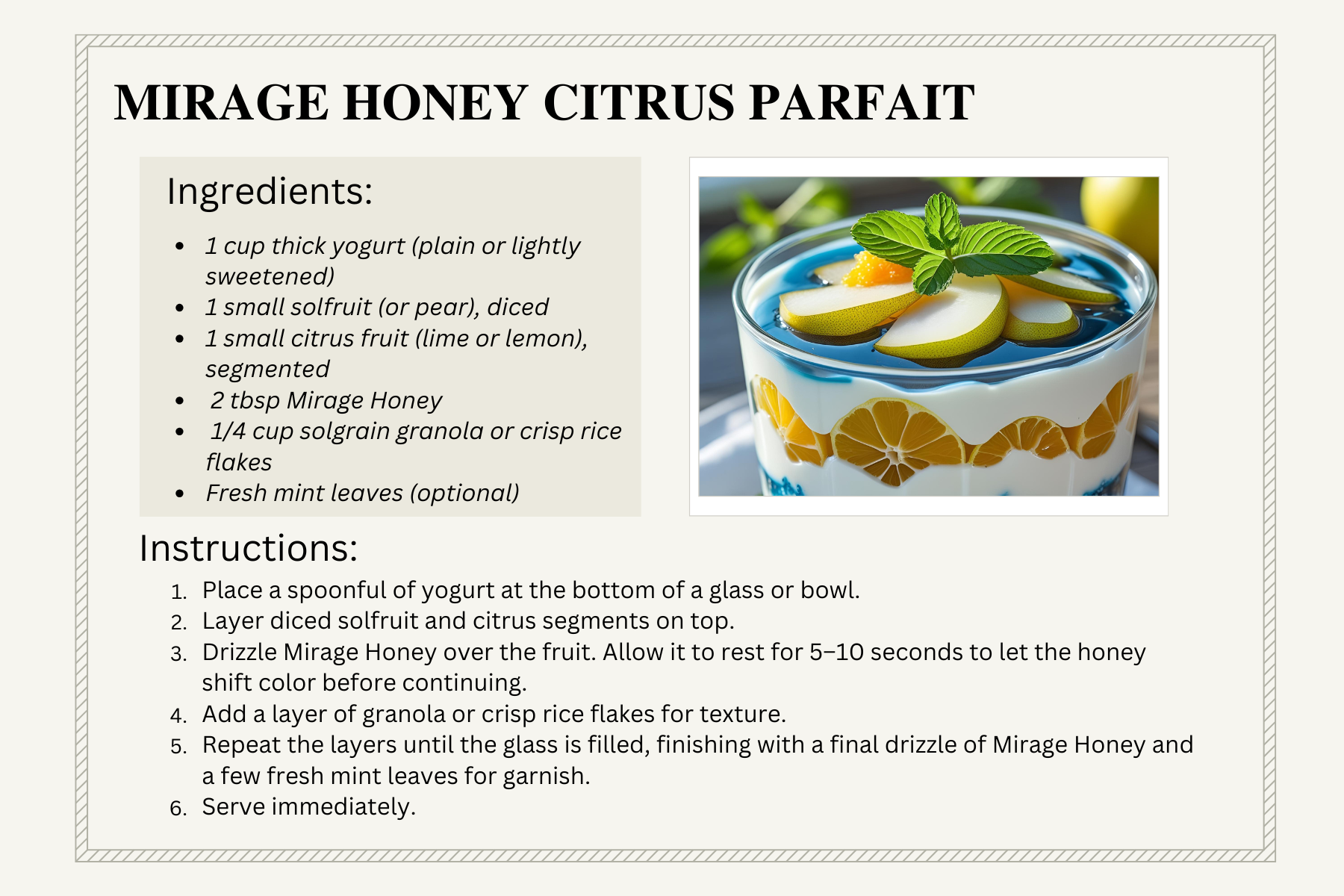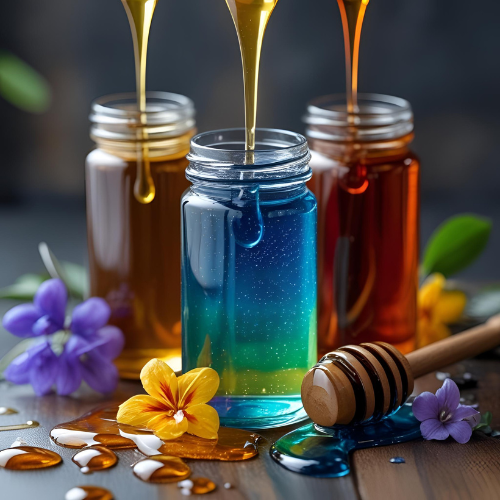Mirage Honey
Mirage Honey is a shimmering, color-shifting honey found on every Cerellean table, from the wealthiest estates in Kalia to small family kitchens on Sona’s riverbanks. Considered a quiet luxury and cultural cornerstone, it reflects Cerellea’s joyful embrace of food as an experience rather than mere sustenance.
Unlike regular honey, Mirage Honey carries a delicate, less sweet profile that lifts rather than overpowers other flavors, pairing beautifully with biscuits, pastries, fruit bowls, yogurt parfaits, and cakes. Its versatility makes it a staple in breakfast spreads, desserts, and afternoon teas across the islands.
Mirage Honey’s flavor and color change based on temperature, which is why many say it shifts “with the eater’s mood.” A warm spoonful may bring out floral or fruity notes, while a cooler bite might reveal herbal or spicy undertones. The honey’s temperature must remain consistent to retain a stable flavor; otherwise, it may shift mid-meal, adding to its mystique at the table. Color changes occur within 5–10 seconds, while the flavor shift is noticeable almost immediately.
Accounting for a significant portion of Cerellea’s gourmet export market, Mirage Honey is prized in high-end patisseries and tea houses abroad. Due to its inability to be artificially replicated, it is a protected export with controlled harvesting quotas to ensure quality and environmental sustainability.
Unlike regular honey, Mirage Honey carries a delicate, less sweet profile that lifts rather than overpowers other flavors, pairing beautifully with biscuits, pastries, fruit bowls, yogurt parfaits, and cakes. Its versatility makes it a staple in breakfast spreads, desserts, and afternoon teas across the islands.
Mirage Honey’s flavor and color change based on temperature, which is why many say it shifts “with the eater’s mood.” A warm spoonful may bring out floral or fruity notes, while a cooler bite might reveal herbal or spicy undertones. The honey’s temperature must remain consistent to retain a stable flavor; otherwise, it may shift mid-meal, adding to its mystique at the table. Color changes occur within 5–10 seconds, while the flavor shift is noticeable almost immediately.
Known Colors and Flavors
- Pale Gold – Floral (jasmine, clover)
- Amber Rose – Fruity (peach, berry)
- Soft Green – Herbal (mint, lemongrass)
- Violet Sheen – Spicy (ginger, cinnamon)
- Blue-Silver – Citrus (lemon, lime)
Culinary Uses
Originally a ceremonial food presented in small glass dishes during family gatherings and festivals, Mirage Honey became an everyday staple as Cerellea’s trade and culinary culture flourished. Chefs continue to develop recipes showcasing its unique properties, using it as a marker of skill in controlling flavor and presentation. It is used in:- Breakfasts: Drizzled over warm biscuits, toast, or solgrain porridge.
- Desserts: Swirled into yogurt parfaits, layered in sponge cakes, or drizzled over fresh fruit bowls.
- Teas: As a light sweetener that shifts flavor with the tea’s temperature.
- Glazes: For roasted fowl or grilled fruit, adding subtle flavor.
- Festival Treats: Featured in candies and pastries during seasonal celebrations.
Cultural Significance and Trade
Mirage Honey is seen as a symbol of adaptability and harmony, representing Cerellea’s ability to thrive and find delight in small moments. Often given as a housewarming or celebration gift to symbolize sweetness and resilience, it sees its highest sales during Golden Week and is widely used in desserts during the Aeru Festival, where its shimmering colors and layered flavors add elegance to festivities.Accounting for a significant portion of Cerellea’s gourmet export market, Mirage Honey is prized in high-end patisseries and tea houses abroad. Due to its inability to be artificially replicated, it is a protected export with controlled harvesting quotas to ensure quality and environmental sustainability.






I want all the honey in different teas! I love how imaginative this is! Its quite wonderful.